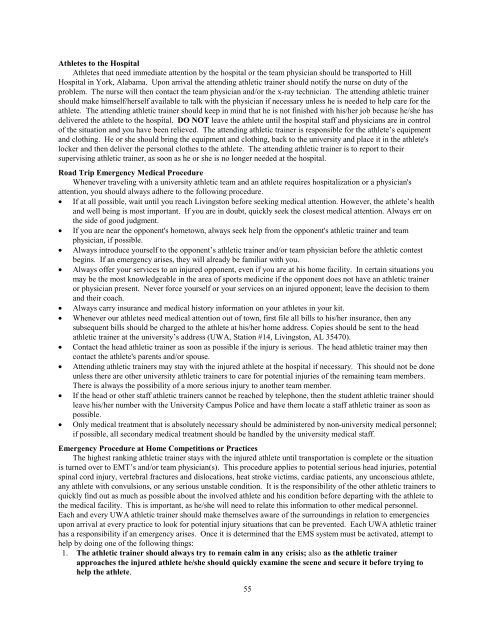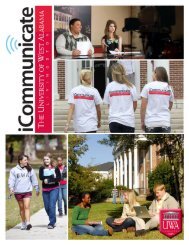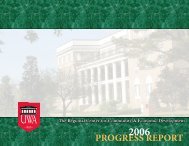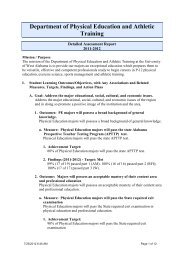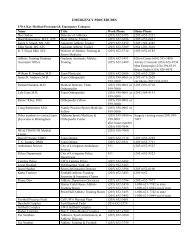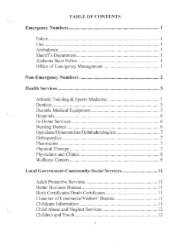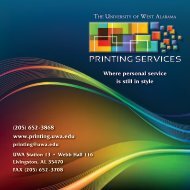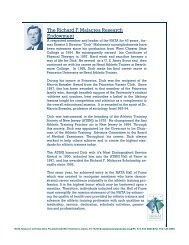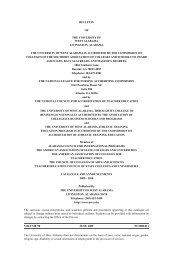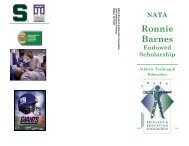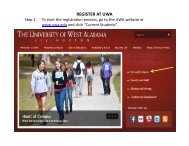table of contents - UWA Athletic Training & Sports Medicine Center
table of contents - UWA Athletic Training & Sports Medicine Center
table of contents - UWA Athletic Training & Sports Medicine Center
Create successful ePaper yourself
Turn your PDF publications into a flip-book with our unique Google optimized e-Paper software.
Athletes to the HospitalAthletes that need immediate attention by the hospital or the team physician should be transported to HillHospital in York, Alabama. Upon arrival the attending athletic trainer should notify the nurse on duty <strong>of</strong> theproblem. The nurse will then contact the team physician and/or the x-ray technician. The attending athletic trainershould make himself/herself available to talk with the physician if necessary unless he is needed to help care for theathlete. The attending athletic trainer should keep in mind that he is not finished with his/her job because he/she hasdelivered the athlete to the hospital. DO NOT leave the athlete until the hospital staff and physicians are in control<strong>of</strong> the situation and you have been relieved. The attending athletic trainer is responsible for the athlete’s equipmentand clothing. He or she should bring the equipment and clothing, back to the university and place it in the athlete'slocker and then deliver the personal clothes to the athlete. The attending athletic trainer is to report to theirsupervising athletic trainer, as soon as he or she is no longer needed at the hospital.Road Trip Emergency Medical ProcedureWhenever traveling with a university athletic team and an athlete requires hospitalization or a physician'sattention, you should always adhere to the following procedure.• If at all possible, wait until you reach Livingston before seeking medical attention. However, the athlete’s healthand well being is most important. If you are in doubt, quickly seek the closest medical attention. Always err onthe side <strong>of</strong> good judgment.• If you are near the opponent's hometown, always seek help from the opponent's athletic trainer and teamphysician, if possible.• Always introduce yourself to the opponent’s athletic trainer and/or team physician before the athletic contestbegins. If an emergency arises, they will already be familiar with you.• Always <strong>of</strong>fer your services to an injured opponent, even if you are at his home facility. In certain situations youmay be the most knowledgeable in the area <strong>of</strong> sports medicine if the opponent does not have an athletic traineror physician present. Never force yourself or your services on an injured opponent; leave the decision to themand their coach.• Always carry insurance and medical history information on your athletes in your kit.• Whenever our athletes need medical attention out <strong>of</strong> town, first file all bills to his/her insurance, then anysubsequent bills should be charged to the athlete at his/her home address. Copies should be sent to the headathletic trainer at the university’s address (<strong>UWA</strong>, Station #14, Livingston, AL 35470).• Contact the head athletic trainer as soon as possible if the injury is serious. The head athletic trainer may thencontact the athlete's parents and/or spouse.• Attending athletic trainers may stay with the injured athlete at the hospital if necessary. This should not be doneunless there are other university athletic trainers to care for potential injuries <strong>of</strong> the remaining team members.There is always the possibility <strong>of</strong> a more serious injury to another team member.• If the head or other staff athletic trainers cannot be reached by telephone, then the student athletic trainer shouldleave his/her number with the University Campus Police and have them locate a staff athletic trainer as soon aspossible.• Only medical treatment that is absolutely necessary should be administered by non-university medical personnel;if possible, all secondary medical treatment should be handled by the university medical staff.Emergency Procedure at Home Competitions or PracticesThe highest ranking athletic trainer stays with the injured athlete until transportation is complete or the situationis turned over to EMT’s and/or team physician(s). This procedure applies to potential serious head injuries, potentialspinal cord injury, vertebral fractures and dislocations, heat stroke victims, cardiac patients, any unconscious athlete,any athlete with convulsions, or any serious uns<strong>table</strong> condition. It is the responsibility <strong>of</strong> the other athletic trainers toquickly find out as much as possible about the involved athlete and his condition before departing with the athlete tothe medical facility. This is important, as he/she will need to relate this information to other medical personnel.Each and every <strong>UWA</strong> athletic trainer should make themselves aware <strong>of</strong> the surroundings in relation to emergenciesupon arrival at every practice to look for potential injury situations that can be prevented. Each <strong>UWA</strong> athletic trainerhas a responsibility if an emergency arises. Once it is determined that the EMS system must be activated, attempt tohelp by doing one <strong>of</strong> the following things:1. The athletic trainer should always try to remain calm in any crisis; also as the athletic trainerapproaches the injured athlete he/she should quickly examine the scene and secure it before trying tohelp the athlete.55


